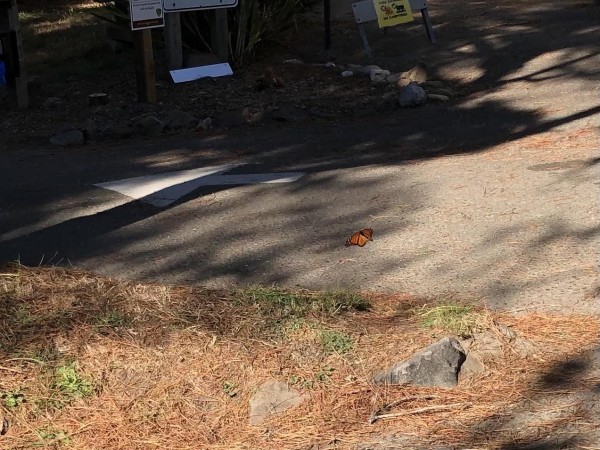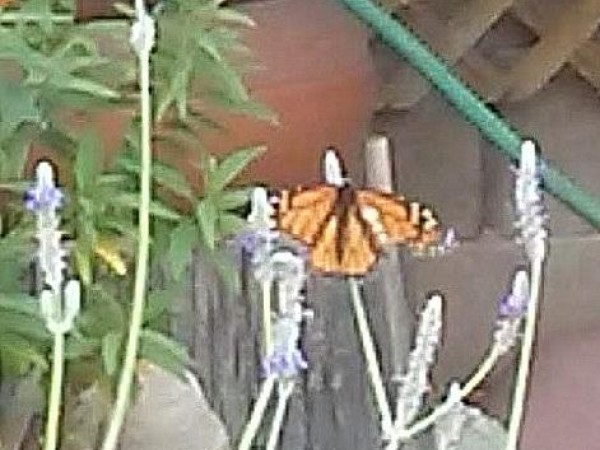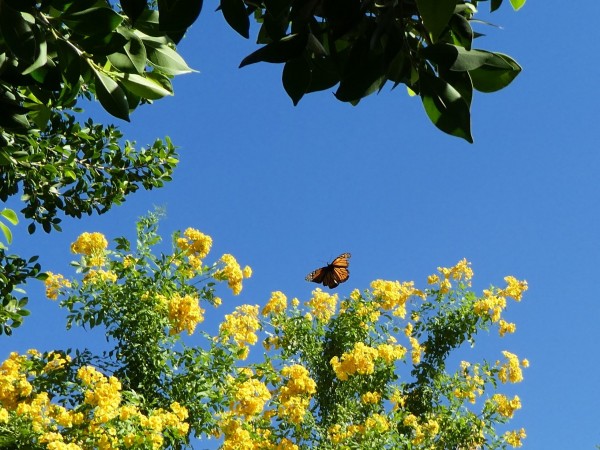Western Monarch Fall Report #10
By Gail Morris, Coordinator of the Southwest Monarch Study
End is in Sight
This week monarch sightings were limited to coastal California and the southern deserts of Arizona after a recent cold spell that dropped temperatures below freezing in the higher elevations of the region. Despite the low temperatures, small pockets of rabbitbrush and other flowers were still available as limited nectar resources to monarchs on the final leg of their migration journey.
Western Sightings
Andrew in Dewey, Arizona, reported one monarch on October 23. “Gender unknown. Flitted about backyard pollinator garden for about 30 seconds seemingly wanting to land on flowers, but elected not to do so. Flew off in a southerly direction.”
Roberta in Jenner, California, saw one monarch on October 26. “Couldn’t get a good photo.” Photos of moving monarchs are always a challenge but we can clearly see Roberta’s monarch!
Patricia found one monarch in Watsonville, California. “First sighting of fall.”
Monarchs are often drawn to plant nurseries. Andrew saw two monarchs in San Diego, California, on October 30. “At Armstrong plant nursery while searching for more pollinator garden plants!”
Cindy reported one monarch in Fairfield, California on October 31. “Single Monarch on a flowering bush.”
Meanwhile in Arizona on October 31, Patty took time out in her day to observe one monarch in her Tempe yard. “I watched a Monarch flying around my yard for over an hour. Finally it landed on my Fernleaf Lavender to nectar several times. It was a male with part of its upper and lower wing missing but it had no problem flying. The picture from my cell phone is not very clear.
On the same day, Suzanne saw one monarch in Petaluma, California. “Visiting my garden.”
On November 1 Tracy found one monarch in Santa Rosa, California. “2nd monarch in garden this year.”
Monarchs continue to straggle through the greater Phoenix area this week. Some days there is only one, other days several, visiting backyards to feed on flowers in bloom then leaving on their way. Some of the monarchs are new looking and appear to be migrators, but others show evidence of torn wings as they stop by.
Every year a few monarchs are still laying eggs in late October and November on our Desert (Rush) Milkweed, A. subulata, a native evergreen. After a brief cold spell, temperatures this week warmed up to match our all-time high temperature for the date. Next week will once again bring cool temperatures with highs in the 60’s. We’ll have to watch carefully to see what will happen to these late observed ovipositions in the lower deserts.
Look for late migrating monarchs
Monarchs are reaching the last leg of their journey as they enter California and Arizona. Keep an eye on the sky and flower patches for laggers still on their way. Migration is still in progress! Remember to take your camera when you are traveling or on a hike or even in your own backyard. Thank you for reporting all your observations – every sighting helps all of us see the bigger picture of monarchs in the West. Submit your observations to Journey North – we look forward to hearing from you!
Gail Morris is the Coordinator of the Southwest Monarch Study (www.swmonarchs.org), a Monarch Watch Conservation Specialist, and the Vice President of the Monarch Butterfly Fund and the Central Arizona Butterfly Association. The Western Monarch Population News is based on comments provided to Gail Morris. We hope to increase the number of sightings and therefore photos and comments entered into the Journey North. We rely on the volunteers who communicate regularly with Gail and who agree to participate in our effort to increase awareness of the population of western Monarchs. You can reach her at gail@swmonarchs.org.




